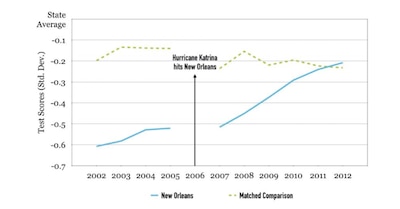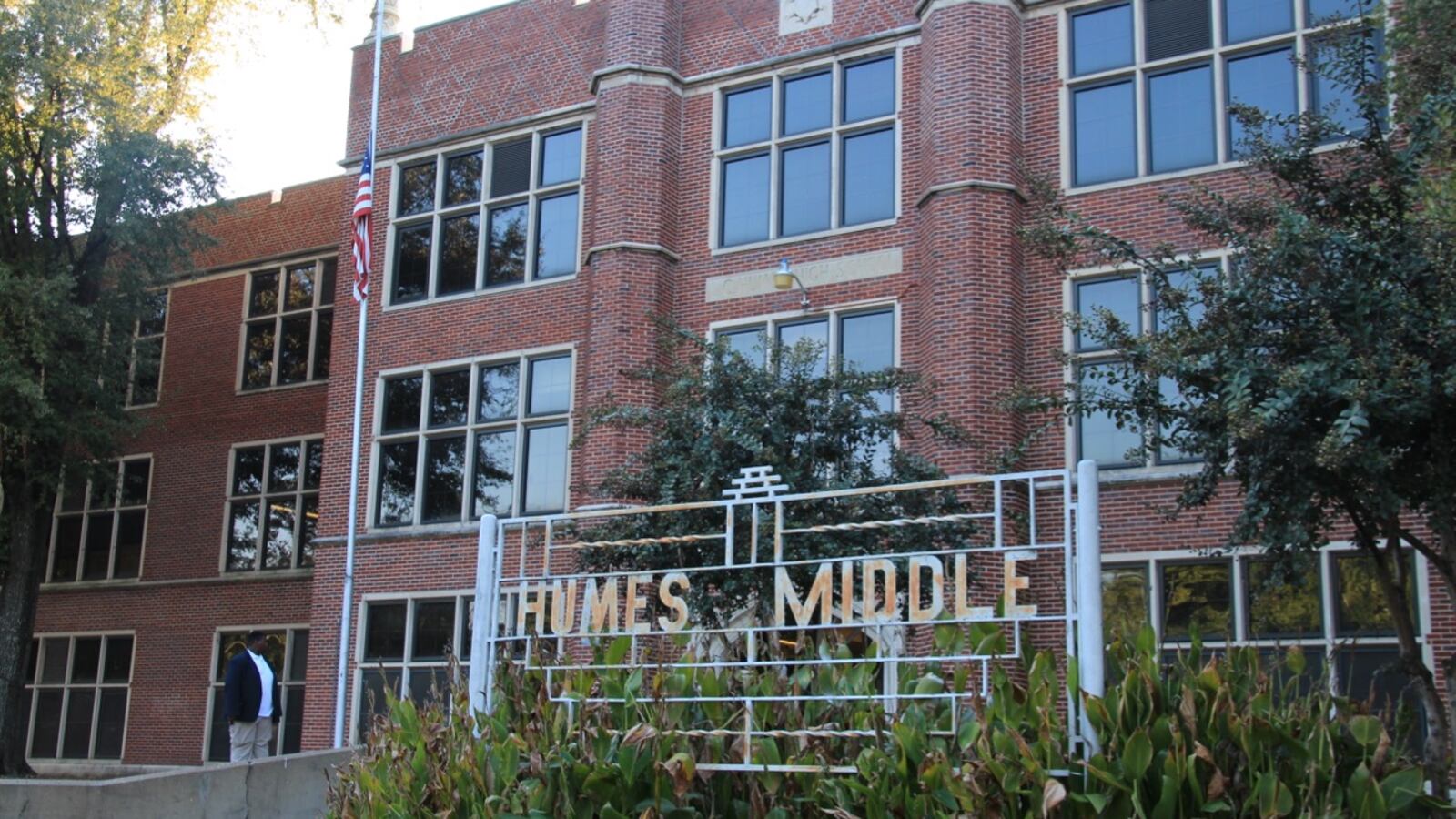Author David Osborne is sure that his vision for improving schools is the right one: “If you discovered a cure for cancer, but it was politically difficult with your union, would you avoid it?”
Neerav Kingsland, another proponent of the idea known as the “portfolio” model, is also optimistic but more cautious. “There’s enough evidence to try it in eight to 10 cities and see if we get good results,” said Kingsland, who leads one foundation’s efforts to parcel out funding for the approach.
“This reform effort might work and so I think it’s really worth trying,” Kingsland said. “We just need to be sober with the evidence.”
As with many education policies, the portfolio model is gaining adherents even while a research base is still being built. Those philanthropists, nonprofit groups, and policymakers — like Kingsland at the Arnold Foundation and Osborne, on a multi-city book tour promoting the approach — are betting big on the idea that schools should be managed more like stocks in a portfolio, where successful ones should expand and failing ones should close.
They point to schools in New Orleans, Denver, Indianapolis, and Washington, D.C., cities that have embraced the model to varying degrees and have seen some education metrics tick up over the last several years.
Whether that amounts to an open-and-shut case for the model is less clear. Here’s a guide to what we do know, and how you can weigh the claims.
First, you should know: It’s difficult to study the portfolio approach, because it’s not a single idea.
Instead, it’s a package of policies that get grouped together, usually put in place across a whole district or city. That’s why comparing districts that have tried the portfolio approach to ones that haven’t is arguably the best approach for finding out whether it “worked.”
But school districts are complicated. Totally different policy changes, or shifting demographics like an influx of wealthier or poorer students, can affect districts too. Without controlling for all of that, a school district’s improvement doesn’t tell us much. That’s where rigorous research comes in.
But there is little or no rigorous research comparing gains in Denver, Indianapolis, and Washington D.C. to similar districts that have gone in a different direction. That doesn’t mean it hasn’t worked in those places — it’s just hard to know.
Second, the gains in New Orleans make a case for the portfolio model.
The city that has most clearly embraced the portfolio approach, New Orleans, has seen big academic achievement gains relative to other districts in the state.

These results were not because of changes in the types of students in the city, according to a Tulane study, and the effects were quite large — akin to seeing the average student in New Orleans gain 8 to 15 percentile points on state tests relative to other Louisiana students between 2007 and 2012. The package of policies also coincided a sharp increase in high school graduation and college attendance.
A national analysis also found that New Orleans students made large academic gains between 2009 and 2015. However, more recent test scores in the city have suggested that schools are backsliding somewhat.
But even those results don’t prove New Orleans’ academic success came from the portfolio model.
A significant share of the city’s academic gains seems to have come from closing low-performing schools. Less talked about — and generally not discussed as part of the portfolio approach — is the substantial infusion of money for schools. This was not just a one-time grant of cash to help schools rebuild: Even several years after Hurricane Katrina, New Orleans schools were spending nearly $1,500 more per student than districts that previously spent the same amount on their schools.
“In most of the places that are thinking about this [model], they’re not thinking, OK, let’s increase spending 15 percent the way they did in New Orleans,” said Doug Harris, the researcher who conducted the Tulane study.
That raises another question about the portfolio model: Even if it succeeded in New Orleans — a very specific context — is it likely to succeed elsewhere?
There’s helpful research on a few other cities. It comes to a mix of conclusions.
In Lawrence, Massachusetts, one study found that the state’s takeover of the district led to substantial gains in math, modest improvements in English, and a growing share of students progressing through high school on schedule. The gains seem to have been driven in large part by expanded learning time, particularly small group tutoring over vacation breaks for certain students.
Lawrence’s approach included aspects of the portfolio model — including a focus on autonomy and accountability — but not others, like school choice.
In Newark, controversial reforms spurred by a $100 million gift from Mark Zuckerberg seem to have had mixed success. Five years later, schools in Newark have higher growth rates in English, but not in math, according to a recent Harvard study, which also found a decline in performance in both subjects in the first three years of change.
The changes in Newark included closing down low-scoring district schools, expanding higher-performing charters, and creating a common enrollment system. Efforts to shift students to better schools seem to have been successful, but existing schools often got worse.
Perhaps the most disappointing results for the portfolio approach come from Memphis. A Vanderbilt analysis found that a state takeover effort known as the Achievement School District failed to raise test scores, even as it was dubbed a “national exemplar” in implementing the portfolio model. Another approach known as the iZone, which granted other Tennessee schools more autonomy, did lead to improvements, according to the same study.
Most of these studies can’t definitively show which specific changes were more or less successful, though.
Studying the portfolio model as a whole is hard. So let’s separate the parts: We do know a lot about charter schools and where they work best (at raising test scores).
Research on charter schools is especially relevant, since the portfolio approach essentially aims to treat every school like a charter — and often leads to a growing charter sector.
A number of national studies show that their charter school students perform about the same as those in nearby district schools. Evidence on charter schools’ long-run impact is still thin.
But research focusing specifically on charters in cities and their impact on disadvantaged students paint a brighter picture. Most studies do show that, in that context, charters — particularly those in nonprofit, city-based networks — are more likely to boost test scores. That’s also been shown in Boston, Chicago, Denver, Indianapolis, Los Angeles, Newark, New Orleans, and New York City.
Supporters of the portfolio model can point to these successes to support their approach, which is focused on cities. There are questions, though, about whether those charter schools perform well in part for reasons other than better teaching, like attracting more girls than boys, not filling empty seats in later grades, or getting substantial amounts of outside money.
School closures can help if students have better options.
The portfolio model emphasizes holding schools accountable for performance — which may mean closing them.
The research on closures has found that in some cases it helps students, in others it hurts them, and sometimes it doesn’t make a difference. Recently, a large national study found that closing low-achieving schools had no overall effect on the displaced students’ test scores.
However, there is strong evidence that, as happened in New Orleans, when students leave closed schools for ones with better test scores, their scores improve, too — and that is closely in line with the theory of portfolio advocates.
Whether school autonomy, another aspect of the portfolio model, really boosts learning is unclear.
On its own, giving district schools more authority over operations like staffing and curriculum has not been shown to consistently improve student learning. For instance, modest efforts along these lines in Boston and Denver haven’t boosted test scores. But results are more positive for Indianapolis’s “innovation schools” and Tennesse’s iZone, both instances where schools were granted additional freedom.
As for negative side effects like increasing segregation, there’s not a lot of research to go on.
Critics of the portfolio model say there will be negative consequences of the model, beyond any changes in test scores. Some of these — like the potential reduction in democratic control caused from letting outside operators runs schools — aren’t about data or research.
Does the portfolio model increase school segregation? Charter schools, which have often expanded in portfolio districts, have been shown in some cases to exacerbate segregation. In districts that have adopted the portfolio approach, the pattern isn’t clear: In New Orleans, the expansion of charters and the portfolio approach had little net effect on segregation, but charter schools in Indianapolis do seem to exacerbate segregation. In Denver the share of students who attend economically segregated schools has dropped moderately since 2012.
Does the portfolio model mean sweeping out veteran teachers of color and replacing them with white teachers? New Orleans has seen a significant decline in the share of black teachers — from about 70 percent to nearly 50 percent — in the wake of the changes, though the loss of black teachers has been seen in a number of other cities as well (including some that didn’t implement portfolio-style changes).
Are there other negative side effects? Some New Orleans principals have acknowledged pushing out low-performing students. (Policymakers have made efforts to address that, though there hasn’t been follow-up research to examine whether those changes have been successful.)
Another concern: expansion of charters in New Orleans coincided with a decline in the number of schools offering prekindergarten, which has been shown to benefit students in the long run.
One potential downside that doesn’t seem to have come to pass in New Orleans: an increase in students moving between schools, which can be disruptive. If anything, the opposite happened, and students changed schools less often.
This is the final part of a three-part series. Part one looks at the push to expand the portfolio model in cities across the country; part two examines how the portfolio movement has played out in one city.
Want more from Chalkbeat today? Sign up for our new national newsletter here.


